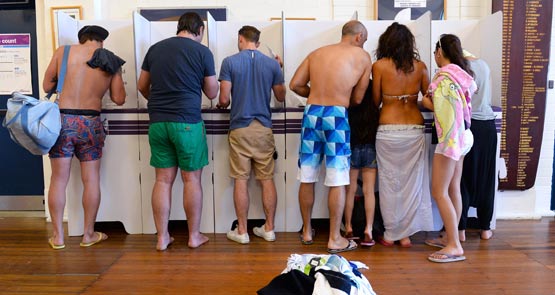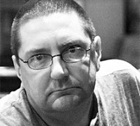
Another election is winding up, so it’s time for the compulsory round of people complaining that the system is flawed and that technology would magically fix some of the problems.
Quite a few are troubled by the pencils, including Clive Palmer, who listed pencils as part of his comprehensive spray against Australia’s “corrupt system”. He told AAP:
“There’s absolutely no way I will win based [on] voting irregularities and the security of the ballots. We think it’s a corrupt system. Until that’s sorted out Abbott won’t be getting any legislation through the Senate with our support.”
But the Australian Electoral Commission has good reasons for using pencils.
“The AEC has found from experience that pencils are the most reliable implements for marking ballot papers. Pencils are practical because they don’t run out and the polling staff check and sharpen pencils as necessary throughout election day. Pencils can be stored between elections, and they work better in tropical areas.”
Besides, if someone intent on defrauding the election broke into the room where the ballots were stored overnight, do you think the best mode of attack would be to erase votes one by one, in a way that couldn’t be detected?
Back here on our own planet, on Tuesday Coalition frontbencher Malcolm Turnbull told ABC News 24 that electronic voting could be a cure for what he sees as the high number of informal votes, around 6% of votes cast for the House of Representatives.
“You could vote in the polling booth, a closed network so it couldn’t be hacked over the internet. And if you misnumbered your boxes, the application would say, ‘you haven’t filled in your form correctly, it’s an informal vote. Do you wish to cast an informal vote?’ And if you said yes that would be your choice. But most people would go, ‘oh gosh’, and they would fill it in correctly.”
But would people really be more likely to understand how to fix their votes because the message would be on a computer screen rather than written on the ballot paper itself?
According to the UN’s Human Development Report 2009, 17% of Australians aged 16 to 65 are functionally illiterate — that is, they lack the reading and writing skills needed to perform daily tasks beyond a basic level. It seems reasonable to imagine that many informal votes are the result of functional illiteracy, and computers won’t fix that.
Nor would computers solve the Senate’s problem of massive ballot papers. Indeed, scrolling back and forth through lists of candidates would be likely to be more frustrating — as a usability expert once put it, like trying to read a newspaper through a keyhole.
Most worrying, though, are calls for a completely electronic voting system, all the way from casting votes to distributing preferences and the final count. That might have the potential to deliver the result quicker, but what’s the rush?
As I wrote in 2011, and in somewhat more detail, the success of an election shouldn’t been measured by its convenience, but by its ability to solve a conundrum: how to combine the complete transparency of process needed to eliminate fraud with the secrecy of individuals’ votes. And transparency is the tricky bit:
“Our paper voting system is easy to understand. Anyone with working eyesight and who can read and count can scrutineer the process. No special skills are required.
“With electronic voting, whether online or on stand-alone voting machines, everything happens inside the invisible cave of computer memory. It’s impossible to see what’s going on at the time the votes are tallied. How can you know that the votes were counted correctly? You just have to trust the system.”
The US experience has shown votes being allocated incorrectly, and then there’s scary story of Diebold Election Systems and whistleblower Clint Curtis.
Even if the voting software is made public, there are still at least four problems. One, how do you know the published software was actually the software in the machines on election day? Two, how do you know the tally hasn’t been altered in some other day, such as through malware manipulating the computers’ memory? Three, how can the process be scrutineered by anyone without specialist — and quite rare — digital forensics skills? Four, can you even be sure the software does what you think it does, given the demonstration given in 2004 by Stanford University’s Daniel Horn, in which software that looked like it tallied votes properly secretly defrauded the election?
No, democracy is worth doing right. Please let’s stick with the trusty pencils, and show due suspicion to anyone who suggests otherwise.








Sensible points made in this piece by Stilgherrian.
Turnbull wrongly assumes –
a) all Australians are literate
b) all Australians are computer literate
I strongly support the pencils.
Dear Skilgherrian Technology Writer,
Whilst I don’t disagree with the points you have made in relation to electronic voting, and acknowledge the problems and existing flaws in those systems already implemented (unsuccessfully), I don’t agree that we should just stop there, halt progress, remain stuck in the pencil and paper age. Surely we can work towards a time when there is a system that is safe, reliable and protected against interference? Your comment “Anyone with working eyesight and who can read and count can scrutineer the process” is reason enough, for vision impaired people, to look forward to an electronic system of voting. While the telephone system, used this year with much success, is a vast improvement upon previous systems whereby a stranger accompanied me to the ballot box, writing down my choices for me, it nonetheless involves someone else recording my vote. Faceless, yes; confidential, yes – but what a shout for independence and even a little self-esteem when I can actually record my vote myself via an electronic voting system – one without the problems you have identified.
Amanda Guildford
Solicitor
Well said Stilgherrian.
Pencil and paper have proven remarkably robust.
Why change an unbroken system?
Indeed. In the US, electronic voting machines are proprietary and the code is the property of the manufacturer. It would be a simple matter to bury code that would activate on election day, and wipe this code after the election. In fact, one such manager declared that he hoped that his machines would help to deliver a victory for Bush in Ohio.
Thanks for a great article. Although I do believe electronic voting would reduce informal votes slightly.
The Coalition will probably promote unauditable electronic voting. Any party which objects will be told to advocate its supporters cast paper votes instead. But then the Coalition’s informal vote will be lower, giving them a percent or two advantage.
Maybe we should consider electronically-assisted voting that prints the ballot out for you. But maybe it isn’t worth the trouble.